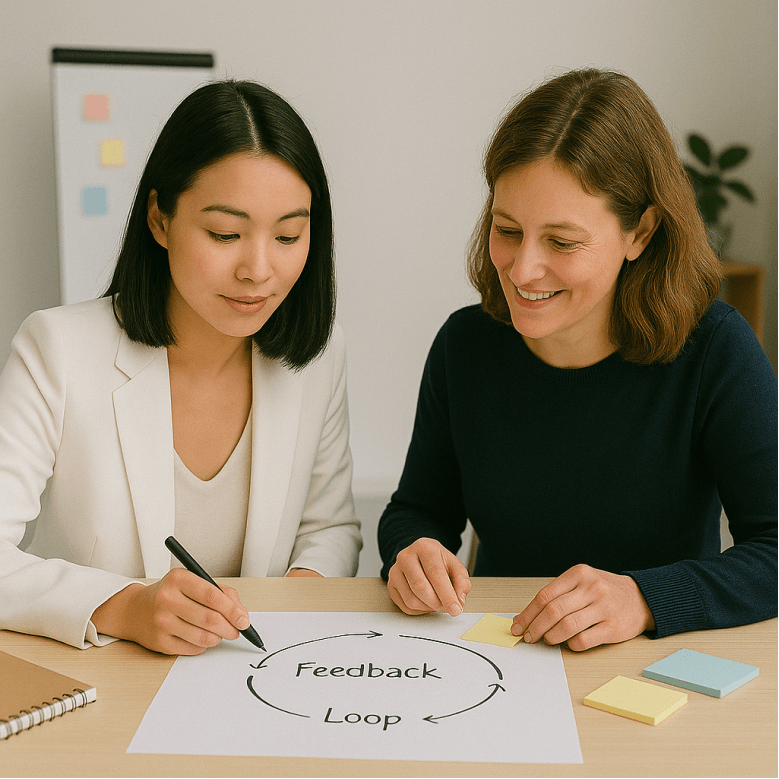Updated: June 16, 2025- 15 min read
Regardless of what many see in their mind’s eye, innovation isn’t born in a eureka moment — it’s forged in refinement.
The products that stand out today aren’t the result of creative genius. They’re the outcome of disciplined, data-driven testing.
The iterative testing method isn’t flashy — it’s about mastering the art of the tweak, which takes time and nerves. Whether you're leading a product team or fine-tuning your product design, the power of iteration can transform an unfinished product into a great one.
The brands that take time to test, adapt, and improve are the ones pulling ahead. Therefore, let’s dive into how iterative testing works, why it’s indispensable for product managers, and how it might just be your competitive edge.
Design Sprint Template
Use design thinking to solve design problems and reduce production risks.
GET THE TEMPLATE
What Is Iterative Testing?
Iterative testing is a systematic approach to improving products, product designs, or processes by testing small changes repeatedly over time.
Instead of making big changes and hoping for the best, iterative testing focuses on experimenting with smaller adjustments. The process forces teams to analyze the results and refine based on insights.
At its core, iterative testing is about learning and adapting.
Each test cycle — often called an iteration — provides data that helps you understand what’s working and what’s not. This cycle of testing, learning, and tweaking ensures that decisions are based on real user feedback or product analysis, rather than assumptions.
Iterative testing example in a real-world scenario
Imagine you’re designing a new app feature — a personalized homepage for users. You release a basic version to a small group of users and observe how they interact with it. The product analytics show that users aren’t clicking on the recommended items section.
A problem? No. A thing to improve? Yes, iteratively.
Instead of overhauling the entire homepage, you tweak one element: the placement of the recommendations.
In the next iteration, you move the section to the top of the page and test it again. This time, clicks improve slightly. So, you go further—changing the design of the recommendations to make them more visually appealing.
Over several iterations, you discover the optimal layout that keeps users engaged.
This step-by-step process is iterative testing in action. Each cycle brings you closer to a better, more effective design — without the risk of committing to a major change that might fail.
Origins of Iterative Testing and Related Methodologies
Iterative testing is rooted in Agile Product Management primarily. It prioritizes continuous improvement through cycles of planning, testing, and refining.
These methods gained prominence in software development and product management as teams sought ways to deliver value while minimizing risk. Rather than aiming for perfection, iterative approaches emphasize learning from small, consistent adjustments—a principle that forms the backbone of many modern types of Agile methodologies and product management frameworks.
Here are some related methodologies that rely on iterative testing:
Scrum:
Scrum is a framework within Agile that breaks work into short cycles called sprints. Each sprint includes opportunities for iterative testing during development and ends with a Sprint Review, where feedback is gathered. This continuous feedback loop helps refine product features and validate assumptions which makes Scrum a natural fit for iterative testing.Agile Methodology:
Agile emphasizes adaptability and incremental progress, with iterative testing integrated into each development cycle. By validating small changes in each iteration, teams ensure they’re on the right path and can pivot quickly if necessary. Agile’s focus on collaboration and user feedback makes it one of the most widely used methodologies for iterative testing.Lean Product Management:
In Lean Development, the focus is on delivering a Minimum Viable Product (MVP) and refining it through iterative feedback loops. Testing and learning quickly help eliminate waste, ensuring resources are spent on features or changes that deliver the most value to users.Design Thinking:
Design Thinking incorporates iterative testing in its prototyping and testing phases, emphasizing user feedback to refine solutions. It encourages rapid experimentation with low-cost prototypes, enabling teams to identify what works before investing heavily in development.A/B Testing:
A/B testing is a practical application of iterative testing. By presenting users with two versions of a feature or design and measuring performance, teams can make data-driven decisions about what to refine in the next iteration.User-Centered Design (UCD):
UCD places users at the core of the design process, relying heavily on iterative testing to align product features with user needs. This ensures that each iteration not only improves functionality but also enhances the user experience.
How do these product iteration methodologies work together?
These methodologies share common principles that make iterative testing effective:
Frequent feedback loops: Continuous validation ensures progress aligns with goals.
Small, incremental changes: Testing manageable adjustments reduces risk.
User-driven focus: Testing ensures that solutions address real needs, not assumptions.
Iterative testing is the common thread in various product management frameworks. It transforms big, risky decisions into manageable experiments that lead to better, more user-centric outcomes.
Usability Testing vs. Iterative Testing
Usability testing and iterative testing serve different purposes. The do, however, also complement each other.
Usability testing focuses on evaluating specific user interactions with a product to identify pain points and improve ease of use. It’s typically conducted at defined stages, such as during prototyping or pre-launch, and involves tasks designed to reveal where users struggle.
Iterative testing, in contrast, is a broader, ongoing process that spans the entire product lifecycle.
It includes multiple user research methods like usability testing, A/B testing, and performance analytics to validate, refine, and adapt products continuously. Usability testing often acts as a subset within iterative testing — it provides focused insights during product discovery or post-launch phases.
Teams combine these methods by integrating usability testing into iterative workflows.
Usability tests provide qualitative data on specific issues, which iterative testing then incorporates into a larger strategy for continuous improvement. Together, they ensure that products are user-friendly, adaptable, and aligned with both customer needs and business goals.
Why Iterative Testing is Beneficial
Assumptions can be expensive. Iterative testing offers a structured way to test them, validate features, and refine designs in small, manageable steps.
By embedding iterative testing into your workflow, you create a constant feedback loop that drives smarter decisions, improves product quality, and keeps your team aligned with user expectations.
It transforms product development from a high-stakes gamble into a calculated, data-driven process. This builds a foundation that every adjustment you make brings you closer to delivering value.
Here’s why iterative testing is essential and how it benefits both product development and design:
Reduces risk of costly mistakes: Iterative testing allows teams to catch and address issues early in the development process. By testing smaller changes incrementally, you avoid investing heavily in a feature or product direction that might fail.
Improves product quality continuously: Each test cycle refines the product based on user feedback or performance data, leading to a polished, high-quality end result. Continuous iterations ensure the product evolves to meet user needs effectively.
Enhances user satisfaction: With iterative testing, you can involve real users in the process, ensuring that the product aligns with their expectations. This user-centric approach often leads to better engagement and satisfaction.
Encourages data-driven decisions: Iterative testing is built on feedback and measurable outcomes. This approach ensures that decisions are based on data, not assumptions, resulting in features and designs that are proven to work.
Speeds up time to market: By focusing on incremental improvements, iterative testing helps teams release functional versions faster. This gives you the chance to gather real-world insights earlier.
Fosters team collaboration and agility: Iterative testing naturally fits into collaborative frameworks like Agile and Scrum, encouraging teams to adapt quickly based on new findings. This agility enables faster responses to market changes or user feedback.
Where Iterative Testing Fits in Product Management and Design
Iterative testing sits at the heart of the product management and product design process. It acts as a bridge between ideation and execution in product-led organizations. It’s not confined to a single phase — it’s a mindset that spans product discovery, product development, and post-launch optimization.
In Product Discovery: Teams employ iterative testing to validate hypotheses and understand user needs. This involves creating prototypes or minimum viable products (MVPs) and conducting usability tests to gather feedback. By iteratively testing and refining product concepts, teams can increase the likelihood of developing successful and impactful solutions before investing heavily in development.
In Dual-track Agile Development: This methodology separates work into two parallel tracks — discovery and delivery. The Discovery track focuses on producing, testing, and validating product ideas, while the Delivery track turns these validated ideas into a final product. Iterative testing in the Discovery track ensures that only well-vetted, user-validated features proceed to development. This reduces the risk of building products that don't meet user needs.
Post-launch Optimization: After a product or feature is live, iterative testing continues through methods like A/B testing, user feedback collection, and product analytics. This process allows teams to make data-driven improvements. This way it ensures the product remains aligned with user expectations and business goals. The iterative nature of the process allows teams to quickly respond to feedback and pivot their strategies as needed.
By embedding iterative testing into each of these stages — discovery, development, and delivery — teams ensure that ideas are not only validated but continuously refined. This approach mitigates risks, aligns cross-functional stakeholders, and prioritizes customer value at every step.
Ultimately, iterative testing transforms the product management process into one that is collaborative, user-centric, and data-driven. In doing so, teams can navigate the delicate balance between speed, quality, and business goals.
Phases of the Iterative Testing Process
The iterative testing process is structured into distinct phases that create a cycle of continuous improvement. Each phase builds on the previous one, ensuring that changes are deliberate, data-driven, and user-focused. Here are the common, shared practices that define these phases:
1. Define goals and hypotheses
This phase sets the foundation for testing by identifying what you aim to achieve and framing clear hypotheses.
Identify the problem or opportunity to address.
Set measurable OKRs (e.g., increase user engagement by 10%).
Write a hypothesis to define what you’re testing.
Example:
“If we simplify the checkout process, then cart abandonment rates will decrease by 20%.”
2. Plan and design the test
Careful planning ensures that tests are structured, efficient, and capable of delivering actionable insights.
Decide on what will be tested (e.g., a feature, design element, or process).
Select the appropriate testing method (e.g., A/B testing, usability testing, etc.)
Define the test parameters: control group, sample size, duration, and success metrics.
Tools:
Use platforms like AB Tasty, Launch Darkly, or Mixpanel to design and implement tests.
3. Execute the test
This is the active phase where the planned changes are implemented, and data collection begins.
Deploy changes to the test group (e.g., release a feature to a subset of users).
Monitor test performance and ensure proper functionality.
Use real-time tools to observe user interactions.
Important Tip:
Ensure changes are incremental to isolate variables and measure their specific impact accurately.
4. Analyze results
Once the test concludes, the data is analyzed to determine whether the hypothesis was supported or disproven.
Compare test group results to the control group.
Use statistical significance tests to validate findings.
Identify trends, anomalies, and actionable insights.
Practical Example:
If a CTA button change increased click-through rates by 12%, analyze whether the improvement justifies rolling it out universally.
5. Iterate based on findings
The insights from the analysis phase feed directly into the next iteration, creating a continuous improvement loop.
Apply successful changes to the broader audience.
Use feedback to design the next test or iteration.
Document results and learnings for future reference.
Example:
If simplifying the onboarding flow increases completion rates, the next iteration might focus on personalizing the experience for users based on their input.
6. Share learnings and scale
A critical but often overlooked phase is sharing insights and scaling successful iterations across the product or organization.
Document the test, results, and learnings.
Apply proven changes to similar areas of the product.
Share results with stakeholders to reinforce the value of iterative testing.
Best Practices for Iterative Testing Methods in Product Management
Iterative testing can revolutionize product development, but even experienced teams can find ways to refine their approach. Here are six best practices to elevate your iterative testing process, complete with actionable insights for Associate Product Managers as well as senior PMs.
1. Define hypotheses with laser-focused clarity
Before starting any test, ensure every iteration is grounded in a clear hypothesis. A vague idea like “let’s see if users engage more” is too broad. Instead, frame hypotheses with precision using the “If X, then Y” format.
If you’re testing a new onboarding flow, your hypothesis might be: “If we simplify the onboarding steps from 5 to 3, then we’ll see a 15% increase in user retention rates.” This clarity focuses your team on a measurable outcome and avoids wasting resources on ambiguous testing goals.
Incorporate user segmentation into hypotheses as well. For instance, “If we introduce a guided tutorial for new users in Segment A, we’ll see a 10% higher activation rate compared to Segment B.”
2. Prioritize high-impact areas first
Not all tests are created equal. Experienced teams should focus iterative testing efforts on areas that directly influence key metrics, such as user retention, activation, or revenue.
Use frameworks like RICE Scoring or MoSCoW to prioritize what to test. Score potential iterations by their expected impact on goals, your confidence in the change, and the effort required to implement and measure it.
Layer your preferred scoring system with customer journey mapping. Identify bottlenecks in the journey (e.g., drop-offs in checkout flows) and prioritize iterations that address those pain points.
3. Incorporate real-time feedback loops
Stay humble but also confident. You've talked to customers, built intuition, so go build the prototype and ship the V1. Then be humble by listening to feedback and iterating.
— Tomer London, Co-Founder at Gusto, on The Product Podcast
Relying on retrospective analysis alone slows down the iteration process. Real-time feedback loops can uncover actionable insights during testing, reducing the time between iterations.
Implement in-app surveys, heatmaps, or session recording tools to capture live user feedback. Use these insights to tweak and re-release tests mid-cycle if necessary.
Create a system for real-time team collaboration on test data. For example, set up automated dashboards with proddy-awarded tools like Mixpanel or Amplitude that pull product metrics instantly, allowing product managers and product designers to make on-the-spot adjustments.
4. Test small, learn big
We did tons of user research to determine what were the models, the messages, et cetera that we were going to go live with, but it was all about the testing and iterative approach that followed that got us to where we are today. So there is a moment where you almost have to take a leap of faith and have a very solid testing plan post-launch that takes you to where you ultimately want to be, which can look very different than what you originally thought.
— Ryan Daly Gallardo, SVP of Consumer Products at Dow Jones (Wall Street Journal), on The Product Podcast
The beauty of iterative testing lies in its ability to break down massive changes into smaller, testable steps. However, it’s easy to overlook the strategic layering of small tests to achieve bigger objectives.
Instead of revamping an entire homepage, let’s say, best teams test elements like button placements, headline copy, or hero image design. Analyze how each change contributes to the overarching goal of, perhaps, an increase in conversion rates or higher CTR.
Use multivariate testing to test combinations of small changes simultaneously. For example, evaluate how different versions of headlines, CTAs, and images interact, then optimize the most effective combination across user segments.
5. Balance speed with rigor in experimentation
Speed is critical in iterative testing, but sacrificing rigor can undermine your results. Senior product managers know they need to strike a balance by refining experimentation processes.
Develop a testing playbook with standardized steps: define objectives, establish control and variation groups, determine sample sizes, and predefine success metrics. This ensures every test is consistent and rigorous.
Apply statistical analysis techniques like Bayesian inference or sequential testing, statistical methods that update the probability of a hypothesis as new evidence is introduced. These approaches allow for faster decisions without compromising accuracy by evaluating significance throughout the product lifecycle.
6. Document everything for scalable learning
Iterative testing is only as good as your ability to learn and share insights. For serious teams, the focus should be on creating a living repository of test learnings to build institutional knowledge.
Use proddy-awarded tools like Monday or Airtable to document every test with key details: the hypothesis, setup, results, lessons learned, and actionable next steps. Ensure this repository is accessible to cross-functional teams.
Ultimately, create pattern libraries, centralized collections of reusable design or code elements, for successful iterations. For example, if a specific call-to-action design improves click-through rates by 20%, add it to a shared design library in Figma for future use.
Iterative Testing: The Engine of Continuous Progress
The best products don’t emerge fully formed—they’re sculpted by iteration, one deliberate adjustment at a time.
Saying it’s just a process is an understatement— it’s a discipline, a commitment to learning through doing, and a refusal to settle for gut feelings, hierarchical privileges, or assumptions.
In product management and design, it’s how teams cut through the noise of complexity to deliver real value. In a world that rewards speed and adaptability, iterative testing isn’t optional — it’s the engine that keeps innovation moving forward, faster and smarter than ever before.
Opportunity Solution Tree Template
Branch out and discover something new with the opportunity solution tree. Visualize the product discovery process to build features that matter!
Get the template
Updated: June 16, 2025





